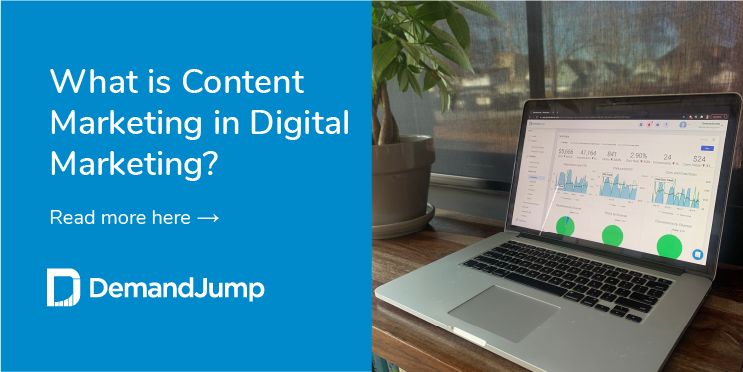What is Content Marketing in Digital Marketing?
November 24, 2020 •Bret Sexton

Digital marketing is all about connecting with your audiences on the internet. One of the best ways marketers have found to communicate with their audience is through content marketing.
In such an ever-changing digital landscape, many individuals and organizations vying for the attention of online users wonder how digital and content marketing blend together. So, what does content marketing mean in marketing? Let’s take a closer look at content marketing first and then see how it fits into the digital realm.
What Is Content Marketing?
We hear that content is king, but what does content marketing involve at its core? Content marketing is another method of providing information to customers and audiences, but it serves many purposes within the realm of digital marketing. In simple terms, content marketing is the creation of informational, educational, or entertainment materials and distributing them through various online networks.
Above all, content marketing should push the reader to some kind of decision. A CTA, or call to action, is usually found at the end of any piece of content. If the content worked, your reader would ideally do what you ask, whether it’s to click through and send an email or read another article.
Content marketing—or at least good content marketing—needs to be many things. First, it must be informative and relevant to the person you’re serving it to. You want them to interact with it and find it helpful. Maybe it solves problems for them. Whatever it is, it needs to mean something to the reader.
Second, it has to serve some kind of goal. It is quite common for businesses to use their content just to raise awareness of their brand. Others use it to establish themselves as thought leaders in an industry by sharing insights they’ve gleaned from the work they do. You get to define what goal you’re trying to achieve with the content you’re creating. This process used to be made up of a lengthy trial and error process, but by partnering with an organization like DemandJump, you’ll never have to guess about what kind of content to make ever again.
Third, it helps if the content you create is entertaining—at least on some level. There is already so much material on the internet for people to click on. So you need to create a reason for them to choose your content instead of someone else's.
You’re asking people to engage with what you’re creating, and we all love to be entertained. If we’re being educated while being entertained simultaneously, all the better.
Depending on who you are trying to reach with your content, the language and tone used can be just as important as answering the right questions and including the right keyword phrases. Having some relatability in your content can prove that you truly understand the needs of your audience, thus driving more engagement to your business.
How Is Content Marketing Different From Digital Marketing?
Before the dawn of our current digital landscape, there may have been a much larger distinction between these two terms. Today, the difference comes down to how technical you want your language to be. Content marketing is a specific technique for using content, while digital marketing is a catch-all term for any type of online promotion. A form of digital marketing that might not directly fit into content marketing would be paid advertising for your website or services. This can get tricky as frequently, what is being advertised is some form of content explaining a service or product. It is generally best to think of these terms working hand-in-hand with one another.
This means most content marketing is going to be digital marketing, but the inverse will not always be true. If that is confusing, don’t worry. If anyone at your company is getting bogged down in the minute details and asking, “Is content marketing different from digital marketing?” you can assure them that it is essentially the same thing.
Is Content Marketing Part of Digital Marketing?
Yes! As we mentioned above, content marketing is more of a digital marketing technique. This connection has, for some, still caused more confusion than clarity with some common questions like “Is content marketing only digital?” or “Is content marketing also digital marketing?” The digital aspect of content marketing is actually quite diverse. The blog you are reading now is one of the most common forms of content marketing. Video content has also exploded in recent years as TikTok has become one of the easier and more unique ways to connect with your audience in short and to-the-point videos.
Is Content Marketing a Type of Digital Marketing?
It 100% is! The best way to understand digital content marketing is to see examples of it. The real beauty of content marketing is that it knows no bounds. If you can create something in some form of media and then get it in front of your audience, you’re content marketing. Let’s look at some of the more common types of content marketing.
Blogs
One of the best-known content marketing types is the humble blog. These articles that live on your website are an opportunity for you to share expert information, relevant stories, or highlight your team or coworkers. They provide SEO value for your site and can attract potential customers to your brand.
The best way that blogs boost SEO value is by answering important questions and including high-value keywords. By answering the questions that your audience is searching for, you can become the authority on a certain subject and drive more traffic to your business.
So what is your target audience searching for? Luckily for you, DemandJump has the answers. Our market intelligence and customer insights will provide your organization with data about your customer's search habits and what your competition is outranking you for on Google. Equipped with these tools, the rest of the market will stand no chance against your content superiority.
Video Content
The next logical step from a blog is video content. You’re still able to share that valuable information, but you’re putting yourself (or someone you trust as the face of your brand) in front of your customers. Adding in the element of personality and voice while still providing quickly digestible information is valuable to people who would rather watch than read. Videos can also be the perfect medium to show a step-by-step process of how to use one of your products, as even after a purchase, customers will still have questions on how to best use it. It could also be a worthwhile investment to make video content on how to fix common problems that customers face early on with your products or services.
Case Studies
Customers love to know that other people love your product or service, too. For that reason, case studies are a prime piece of content that are easy to produce. Case studies can put to rest some of the reservations a potential customer may have about your business or product. Having the ability to show off the “before” of a company that had not used your services and then show off the “after” is an easy way to demonstrate your value. For example, if you sell customer relationship management (CRM) software, and you have a case study showcasing concrete data where after using your services, they turned 25% of their customer base from freemium members to premium members, the work has just sold itself.
Infographics
Infographics add a visual element to otherwise quickly digestible bits of information. Often based on numbers or data, they’re an engaging way to spiff up information that people otherwise may simply glaze over. The data in your infographic does not always have to take shape in the form of a generic graph, either. You could include a colorful snapshot of an important piece of data and just show that number rather than bogging the reader down with a large data set.
Whitepapers, ebooks, emails, how-to guides, podcasts—this list could go on forever. The most important thing is to meet your audience where they are, and produce content specifically for those channels. You can look at other channels as well, and you may see benefits from them, but don’t expect someone who spends half the day on YouTube to come read a long-winded ebook.
How to Do Content Marketing
Not every organization will have a content creation team, which can push them to ask, “What is the use of content marketing?” The great news is that content marketing is so incredibly accessible. It doesn’t matter if you’re a marketer by trade or anything else. You can create content. Granted, you can’t create it without some sort of strategy, but there are simple steps to take to get you there. You can also outsource your content creation needs to a third-party company (we hear DemandJump is a pretty good option).

First, find where your audience is. Do they spend their time on YouTube watching how-to videos, or do they read lengthy instruction manuals? Create content for the places where they’re already going. This will help ensure that your organization is making efficient use of its time when it comes to marketing digital marketing efforts. It is also essential to understand how often these platforms can change and the rate at which new social media platforms pop up. Having some kind of presence on the most popular social media sights means that your audience will always be able to see and engage with you.
Next, create a list of topics you can talk about. Start with questions you get frequently asked by customers or clients. Move on to relevant things in your business that only an expert would know how to do or interesting topics.
Finally, ask for what you want. Want them to share your blog post? Fill out a form for a free consultation? Stop into your store? Use a clear call to action at the end of your post that asks for what you’re after. Never expect someone to simply do it on their own. You’re far more likely to get the action you want when you ask for it.
DemandJump: Become the King of Digital Content Marketing
We hope that this blog has cleared up any confusion or answered all your burning questions about what is digital content marketing?
The primary purpose behind content marketing—like any marketing—is to generate leads and drive sales. Want to know which content is driving people into your pipeline and closing revenue? DemandJump connects marketing and sales data to help you find what’s working. That way, you keep creating successful content, and keep driving sales.
Featured Articles
Categories
- Attribution Tracking (13)
- Channel Optimization (11)
- Consumer Insights (68)
- Content Marketing (251)
- Data Science (8)
- Digital Marketing (6)
- Digital Transformation (26)
- Enterprise (10)
- Lead Generation (14)
- Market Intelligence (8)
- Marketing Analytics (39)
- Marketing Attribution (57)
- Marketing Management (153)
- Marketing Operations (86)
- Organic Search (222)
- Paid Search (52)
- Pillar-Based Marketing (63)
- Programmatic Advertising (9)
- SaaS Content (14)
- SaaS Marketing (29)
- Search Marketing (111)
- SEO Keyword Research (28)
- SEO Pillar (18)
- SEO Strategy (46)
- SMB (5)
- Website Content (12)


